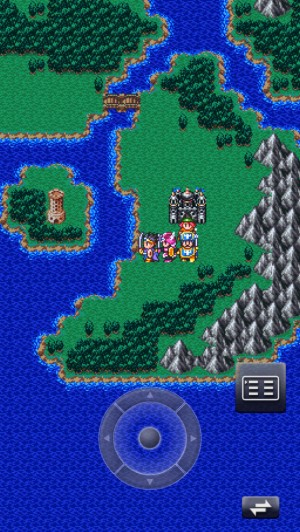 I’ve been working my way through the new iOS version of Dragon Quest 3 since it hit the Japanese App Store last week, and now that I’ve finally brought peace back to the land, I figured I would give you some deeper impressions about the game. This game has been confirmed for English release, though we don’t have a date any more specific than within a few months of Dragon Quest 1 ($2.99)’s release. I don’t expect there will be any substantial changes from the version I’ve been playing, beyond translating the text and separating it out into its own app as opposed to its current form as IAP for the Dragon Quest Portal app.
I’ve been working my way through the new iOS version of Dragon Quest 3 since it hit the Japanese App Store last week, and now that I’ve finally brought peace back to the land, I figured I would give you some deeper impressions about the game. This game has been confirmed for English release, though we don’t have a date any more specific than within a few months of Dragon Quest 1 ($2.99)’s release. I don’t expect there will be any substantial changes from the version I’ve been playing, beyond translating the text and separating it out into its own app as opposed to its current form as IAP for the Dragon Quest Portal app.
Dragon Quest 3 is the third installment in the popular, long-running JRPG series. It’s where the series, in Japan, went from being popular to being a part of the modern culture. Its popularity was such that there was an urban legend passed around for years that the Japanese government had passed a law banning Enix from releasing Dragon Quest games on weekdays due to everyone skipping work or school. That’s not true, of course, but the government did jokingly suggest it, and that in and of itself is pretty noteworthy. More important than Dragon Quest 3‘s sales is its content, however. After the spartan experience of Dragon Quest 1 and the ambitious but highly flawed follow-up Dragon Quest 2, the team behind the Dragon Quest series finally hit it out of the park with this game. It’s a big adventure with plenty of customization and just the right amount of non-linearity to make the player feel like it’s their story. It makes excellent use of its world and has meaningful connections to the previous games, and although the story is very simple by today’s standards, its main hook is still pretty powerful.
This version of Dragon Quest 3 is a port of a feature phone remake released only in Japan in 2009. It was the third remake of the game, following on the Japan-exclusive Super Famicom version and the Game Boy Color version which was released in the US and Japan. It borrows the look of the 16-bit SFC remake along with most of the gameplay changes. If you’re familiar with the GBC version, you’ll probably be wondering where a few things went. The monster medals and the bonus dungeon from the GBC version didn’t make the cut, and the opening animation featuring the hero’s father along with the dice game from the SFC version are also out. The Zenithia bonus dungeon from the SFC version is still in, and you can now set your party members to be controlled by the computer AI if you’re that-way inclined. The music has been replaced with orchestral arrangements, and unlike Dragon Quest 4 ($14.99), the tracks don’t loop back to the beginning after every fight. All of the items that were originally only found in the dice game are now distributed through collecting tiny medals hidden around the world.


As I already mentioned, it visually takes after the Super Famicom version, except for a few details. Characters have had their heads redrawn to show their facial expressions a little bit better, and monsters no longer animate in battles, a particular disappointment since even the GBC version had nicely-animated enemy sprites. Unlike the ports of Dragon Quest 1 and 2, the sprites have been scaled correctly in this version of Dragon Quest 3, so that weird stretched look that made the pixels look a bit too obvious in those games isn’t a problem here. It looks fantastic, and is probably one of the better attempts at carrying over 16-bit graphics that I’ve seen. The new music arrangements sound wonderful, and I hadn’t heard some of these versions before, so that was a treat. The controls are set up similar to the other recent Dragon Quest releases on iOS so, apart from a few tricky navigational challenges around pits, the game plays really well, even one-handed. Unfortunately for those looking to play the games in landscape mode, this one is once again only playable in portrait mode.
It’s pretty much the same old Dragon Quest 3, and that’s a great thing. If you haven’t played it before and like JRPGs, feel free to start getting excited. It’s still a great game and probably the earliest point in the series that doesn’t feel terribly outdated in some way. I’m not sure if I like this particular version better than the GBC version, even with much better graphics, but it really only suffers by comparison. Taken on its own, this iOS version looks and plays great, and will instantly be among the top JRPGs available to English mobile gamers when it finally releases worldwide. I’m interested to see how Square Enix handles the new translation. Since the adventure spans a world based on Earth’s map, there should be plenty of opportunities for the accent chicanery this series likes to indulge in of late. Sadly, we have to get through the somewhat less great Dragon Quest 2 in English first, but the wait shouldn’t be too long.